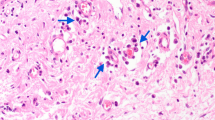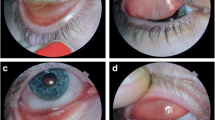Abstract
We report a 29-year-old white female with conjunctival pigmentation after a Stevens–Johnson syndrome (SJS) episode triggered by sulfasalazine. The patient developed bilateral tarsal and forniceal conjunctiva and black pigmentation. Diagnostic biopsy showed stromal monocyte infiltration consistent with chronic phase SJS and conjunctival pigment of melanic origin and not due to drug deposition. Treatment with topical steroids and unpreserved artificial tears resulted in improvement of clinical symptoms; however, pigmentation was unchanged after 2 years.


Similar content being viewed by others
References
Bastuji-Garin S, Rzany B, Stern RS, et al. Clinical classification of cases of toxic epidermal necrolysis, Stevens–Johnson syndrome, and erythema multiforme. Arch Dermatol 1993;129:92–6.
Power WJ, Ghoraishi M, Merayo-Lloves J, et al. Analysis of the acute ophthalmic manifestations of the erythema multiforme/Stevens–Johnson syndrome/toxic epidermal necrolysis disease spectrum. Ophthalmology 1995;102:1669–76.
DiPascuale MA, España EM, Liu TS, et al. Correlation of corneal complications with eyelid cicatricial pathologies in patients with Stevens–Johnson syndrome and toxic epidermal necrolysis syndrome. Ophthalmology 2005;112:904–12.
Roujeau JC, Kelly JP, Naldi L, et al. Medication use and the risk of Stevens–Johnson syndrome or toxic epidermal necrolysis. N Engl J Med 1995;333:1600–7.
Varkonyi V, Torok I, Marta D, et al. Lyell’s syndrome caused by salazopyrine. Orv Hetil 1976;117:971–3.
Garcia e Silva L. Erythema multiforme, ulcerative colitis and salazopyrine. Acta Med Port 1986;7:71–2.
Borras-Blasco J, Navarro-Ruiz A, Matarredona J, et al. Photo-induced Stevens-Johnson syndrome due to sulfasalazine therapy. Ann Pharmacother 2003;37:1241–3.
Folberg R, Spencer W. Melanocytic lesions in the conjunctiva. Conjunctival pigmentations from topical systemic medication. In: Spencer WH, editor. Ophthalmic pathology an atlas and textbook, Philadelphia: Saunders; 1996. pp. 87–147.
Chevez-Barrios P, Font RL. Pigmented conjunctival lesions as initial manifestation of ochronosis. Arch Ophthalmol 2004;122:1060–3.
Pau H, Schmitt-Graff A. Pigmented deposits into conjunctiva after local application of epinephrine. Albrecht Von Graefes Arch Klin Exp Ophthalmol 1981;216:69–75.
Bradfield YS, Robertson DM, Salomao DR, et al. Minocycline-induced ocular pigmentation. Arch Ophthalmol 2003;121:144–5.
Sandhu K, Gupta S. Localized cutaneous pigmentation induced by subcutaneously inserted copper wire. J Dermatol 2001;28:767–8.
Greenberg JE, Lynn M, Kirsner RS, et al. Mucocutaneous pigmented macule as a result of zinc deposition. J Cutan Pathol 2002;29:613–5.
Zografos L, Uffer S, Chamot L. Unilateral conjunctival-corneal argyrosis simulating conjunctival melanoma. Arch Opthalmol 2003;121:1483–7.
Koren R, Bernheim J, Schachter P, et al. Black thyroid adenoma. Clinical, histochemical, and ultrastructural features. Appl Immunohistochem Mol Morphol 2000;8:80–4.
Imokawa G. Autocrine and paracrine regulation of melanocytes in human skin and in pigmentary disorders. Pigment Cell Res 2004;17:96–110.
Jullien D, Wolkenstein P, Roupie E, et al. Toxic epidermal necrolysis after sulfasalazine treatment of mild psoriatic arthritis: warning on the use of sufasalazine for a new indication. Arthritis Rheum 1995;38:573.
Ruiz-Maldonado R, Orozco-Covarrubias ML. Postinflammatory hypopigmentation and hyperpigmentation. Sem Cutan Med Surg 1997;16:36–43.
Abdel-Malek ZA, Swope VB, Nordlund JJ. The nature and biological effects of factors responsible for proliferation and differentiation of melanocytes. Pigment Cell Res 1992;2:43–7.
Acknowledgment
Graciana Fuentes-Paez was supported by a grant from Carolina Foundation, Ministry of Foreign Affairs, Spain.
Author information
Authors and Affiliations
Corresponding author
Additional information
Editor’s Preface
Examination of the conjunctiva/sclera and surrounding structures is an important component of any physical exam. The articles by Dr. Fuentes-Paez et al. and by Dr. Sharma et al. provide critical information for a good exam of the eye and surrounding structures. Reading these two articles in conjunction with a basic text of ocular microanatomy will provide a great refresher course on this topic. More importantly, it will also provide an invaluable guide to understanding the dynamics of changes in color and texture of the conjunctiva and surrounding tissue.
TAG LINE: We report a case of conjunctival pigmentation after a Stevens–Johnson syndrome episode triggered by sulfasalazine treated with topical steroids and unpreserved artificial tears resulting in clinical improvement but persistent pigmentation.
About this article
Cite this article
Fuentes-Páez, G., Mendez, M.C., Montañez, J. et al. Conjunctival Pigmentation in Stevens–Johnson Syndrome. Compr Ther 33, 99–103 (2007). https://doi.org/10.1007/s12019-007-8009-4
Received:
Accepted:
Published:
Issue Date:
DOI: https://doi.org/10.1007/s12019-007-8009-4




